Disparities and Discrimination
Issues of race and race policy are understood by most Americans as being about individuals and relationships, not systems and structures, and that means the explanation for gaps in achievement are often understood as resulting from personal successes or failures rather than external influences.
Therefore, even if people recognize that disparities exist, they often blame disparities on individual failures alone, not systemic influences. Furthermore, if people recognize that discrimination exists, many think it is solely due to personal prejudice and do not see the influence of institutional racism. Overcoming this dynamic will be a central challenge for those who seek policy solutions.
Knowledge of disparities
White survey respondents recognize that disparities, such as economic disparities, exist between black and white Americans. However, research suggests that respondents, particularly white respondents, underestimate the size of the gaps. In an analysis by Kaplowitz, Fisher, and Broman entitled “How Accurate are Perceptions of Social Statistics about Blacks and Whites” (2003), in rating statistics, black respondents offered larger gap estimates than white respondents in three of four areas (excepting family income).4
Furthermore, white respondents tend to believe things are getting better for black men as a group (according to 58 percent of white men and 50 percent of white women surveyed), while black men are far more mixed in their views. Only 29 percent of black men believe things are getting better for black men as a group, while 34 percent believe things are getting worse, and 36 percent say things are staying about the same. (Washington Post/Kaiser Family Foundation/Harvard University, 2006)
But would more accurate knowledge help or hurt efforts to address disparities? If people had more accurate knowledge of the disparities that exist, would it inspire them to address them? Or would it just feed negative stereotypes?
The answer to this question depends in large part on people’s reasoning for why disparities exist. Even if there is widespread agreement that there are inequities between white and black Americans, there is a fundamental disagreement about the cause of inequities. According to Nicholas Winter (2008), some attribute disparities to individual factors, such as individual effort, while others attribute disparities to structural factors.
The General Social Survey (GSS), a survey conducted periodically since 1972 by the National Opinion Research Center (NORC) at the University of Chicago that tracks opinions of Americans on a large range of issues, routinely asks questions designed to measure people’s understanding of structural vs. individual influences on disparities, such as economic disparities. Asked to explain why on average blacks “have worse jobs, income, and housing than white people,” respondents choose responses rooted in both individual and structural explanations. Equal percentages choose a measure grounded in individual responsibility (“motivation to pull themselves up”) and structural obstacles (“have the chance for education”). Few choose the blatantly prejudiced belief that black people have less ability to learn. One-third point to discrimination, a measure that white and black people may understand very differently. (GSS, 2010, NORC; see table)
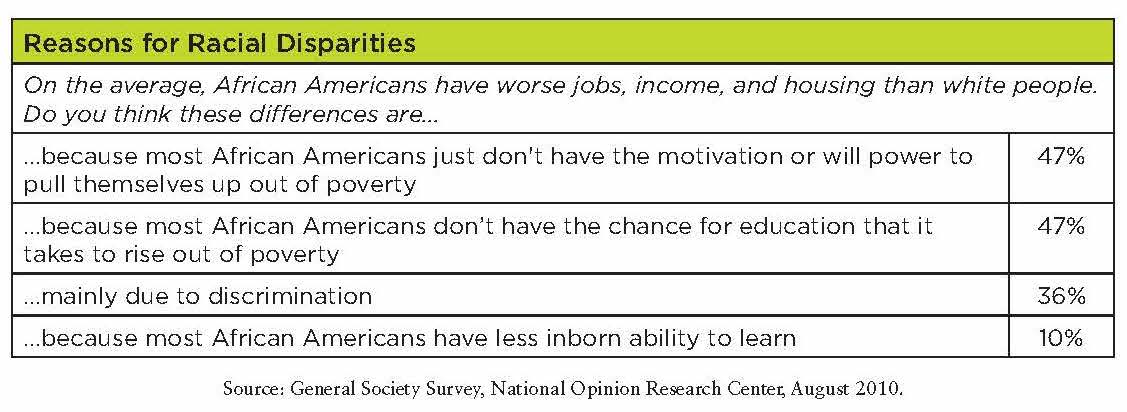
More accuracy in pinpointing the breadth and depth of disparities is unlikely to matter if people continue to hold onto explanations for disparities that absolve government or other structures from responsibility. The next section discusses three different types of responsibility for disparities that are addressed in survey data, and whether or not each leads to public support for collective action.
Who’s responsible?
This section discusses three perspectives regarding responsibility for disparities and solutions:
Interpersonal responsibility — Disparities exist because of those who demonstrate prejudice in their interpersonal relationships; therefore, prejudiced individuals are responsible for disparities and attitude change is the solution.
Structural responsibility — We all share responsibility in creating systems that allow disparities; therefore, institutions and structures continue to perpetuate disparities, and policy change is the solution.
Personal responsibility — Responsibility for achieving their own success belongs to individuals; therefore, it is up to individuals to create their own solutions.
Before further discussion of responsibility, it is important to describe people’s understanding of discrimination, and how it shapes their views of disparities and responsibility for action.
“Discrimination” is an issue that can be understood as “interpersonal” (meaning how individuals treat each other, or “individual racism”) or “structural” (meaning racism that is embedded in systems and institutions, or “institutional racism”). These marked differences in understanding often go unstated in public opinion surveys. In fact, surveys frequently ask questions that imply the existence of individual racism only, and obscure the role of structures.
Discrimination — widely divergent views
While Americans of differing races agree that discrimination continues in the United States, they assess the prevalence and consequences of discrimination differently. Black respondents are far more likely than white respondents to assert there is “a lot” of discrimination, that racism is “widespread,” and that it leads to a number of consequences.
Overall, 69 percent say there is “a lot” or “some” discrimination against African Americans. Black respondents are more likely to say there is discrimination (82 percent, 43 percent “a lot”) than white respondents (70 percent, 13 percent “a lot”) or Latino respondents (54 percent, 19 percent “a lot”). (Pew, 2009) Similarly, black respondents believe racism against blacks is widespread in the United States (72 percent), but whites are divided (49 percent widespread, 48 percent not widespread). (Gallup, October 2009)
The marked difference between black and white respondents occurs even among the youngest age groups. While 61 percent of black youth agree with the statement, “it is hard for young Black people to get ahead because they face so much discrimination,” just 43 percent of white youth agree. (Black Youth Project, University of Chicago, 2005)
At the same time, the Pew Research Center found in its 2008 “Political and Economic Survey” that a majority (53 percent) of Americans believe the country is making progress in addressing discrimination against minorities. Among a number of challenges, this is the one area in which people think the country is making progress. Even so, young people are skeptical that discrimination will be eliminated — just 11 percent of black youth and 4 percent of white youth say that it is very likely racism will be eliminated during their lifetime. (Black Youth Project, University of Chicago, 2005)
For black respondents, discrimination matters in part because it leads to serious consequences — such as gaps in income and education (see Figure 7). Far fewer white respondents believe racial discrimination is a major factor leading to these gaps.
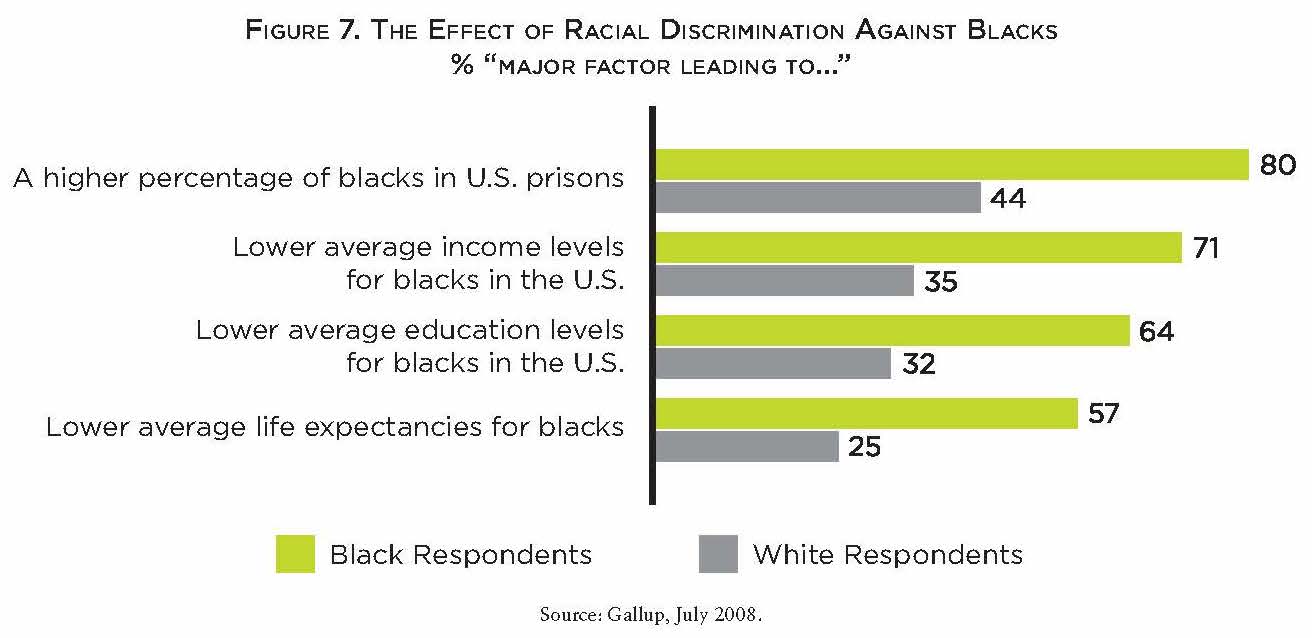
Responsibility — interpersonal relationships
As noted above, one way of understanding what racial bias is “about” is grounded in interpersonal relationships. In this view, the problem is seen through the lens of how individuals treat each other; therefore, the solution is attitude change and stripping culture of stereotypes on an individual level.
A main focus in public opinion research has been the investigation of “relationships” between people of different races. In these types of questions, the focus is interpersonal: do people of different races get along, have people been treated unfairly by other individuals due to race, etc. The unstated assumption is that discrimination is based on interpersonal relationships and if people would treat each other fairly, disparities would close.
Most Americans believe that race relations are good, that problems will be worked out, and that more dialogue will help.
According to a Hart/McInturff survey for NBC/Wall Street Journal (2010), majorities across races believe relationships between the races are “good,” with white respondents rating race relations slightly more positively than black respondents — 72 percent of white respondents and 66 percent of black respondents say relations between whites and blacks are “very” or “fairly good.” These ratings jumped in the January 2009 Hart/McInturff survey, just prior to Barack Obama’s inauguration as president. In fact, at that time significant percentages of both white and black respondents believed race relations had gotten better since Barack Obama’s election (46 percent and 40 percent, respectively), but numbers dropped one year later (19 percent and 22 percent, respectively, said “better”).
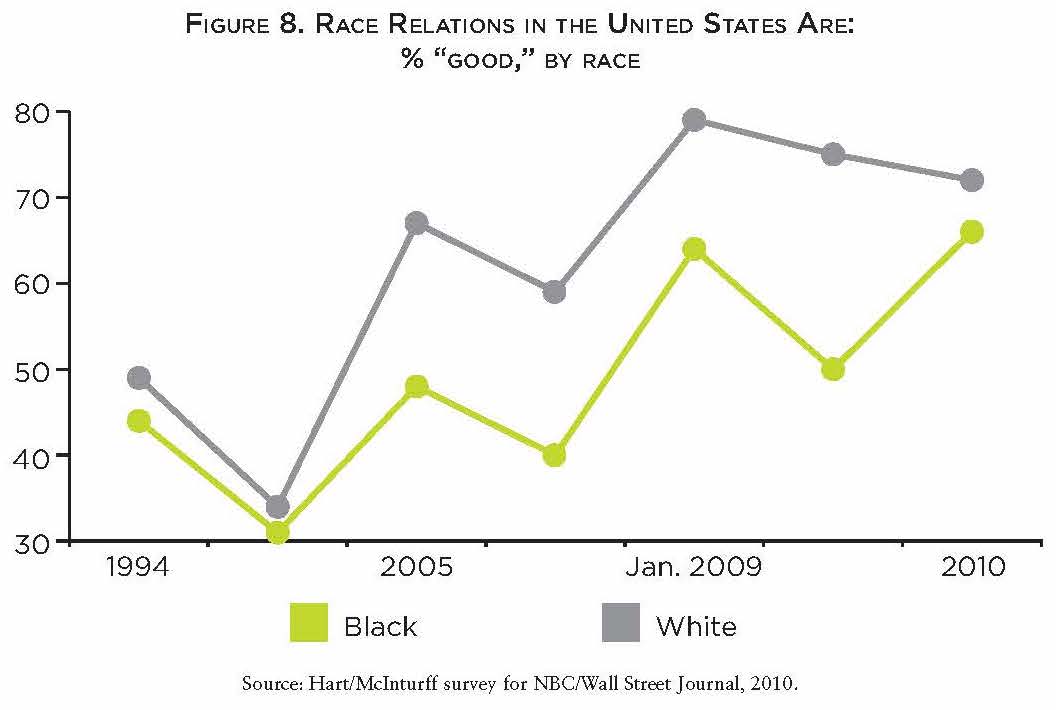
A Gallup poll from October 2009 showed that a majority (56 percent) believe relations between the races will eventually be worked out. Overall, the ratings have improved since the early 1990s, hitting a high of 67 percent in November 2008.
In looking at the issue from the “interpersonal” perspective, conversation is viewed as a valid solution. Most people believe greater dialogue about race would bring the races together (56 percent overall). Black respondents in particular believe this is true (70 percent). (Gallup, 2009)
Personal slights (being treated with less respect, receiving poor service, etc.) are often the focus of survey questions that purport to measure discrimination. Many black Americans, particularly black men, report that they have experienced this kind of behavior.
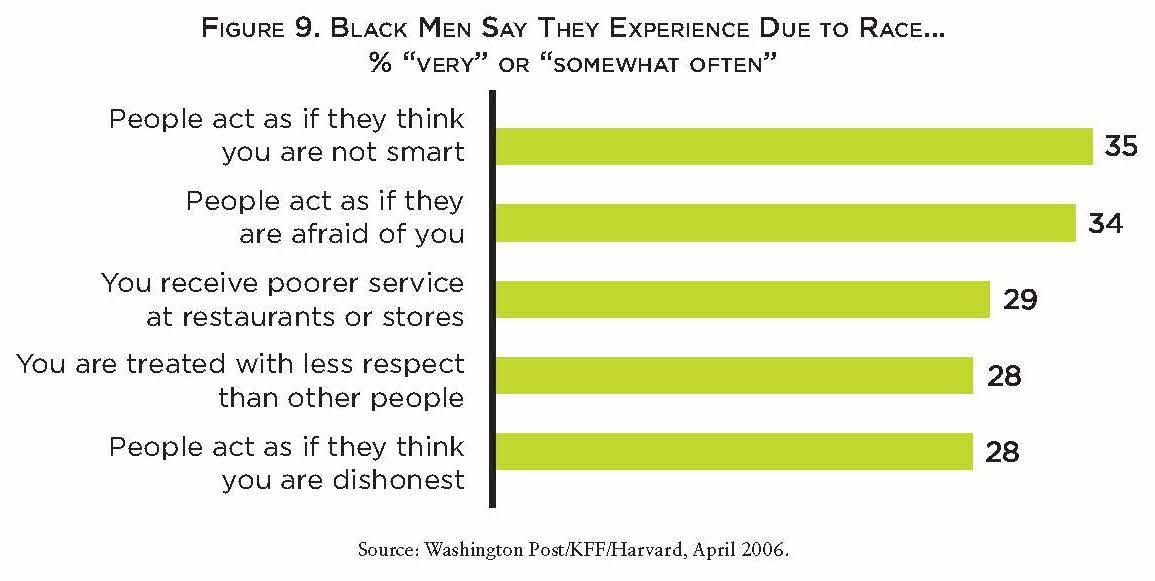
Between one-quarter and one-third of black men say they have experienced mistreatment by others due to their race very or somewhat often in their “day-to-day life” including: “people act as if they think you are not smart” (35 percent of black men experience this “very” or “somewhat often”), “people act as if they are afraid of you” (34 percent), “you receive poor service” (29 percent), “you are treated with less respect” (28 percent) and “people act as if they think you are dishonest” (28 percent) (see Figure 9). As a point of comparison, responses among white respondents are in the single digits in each category.
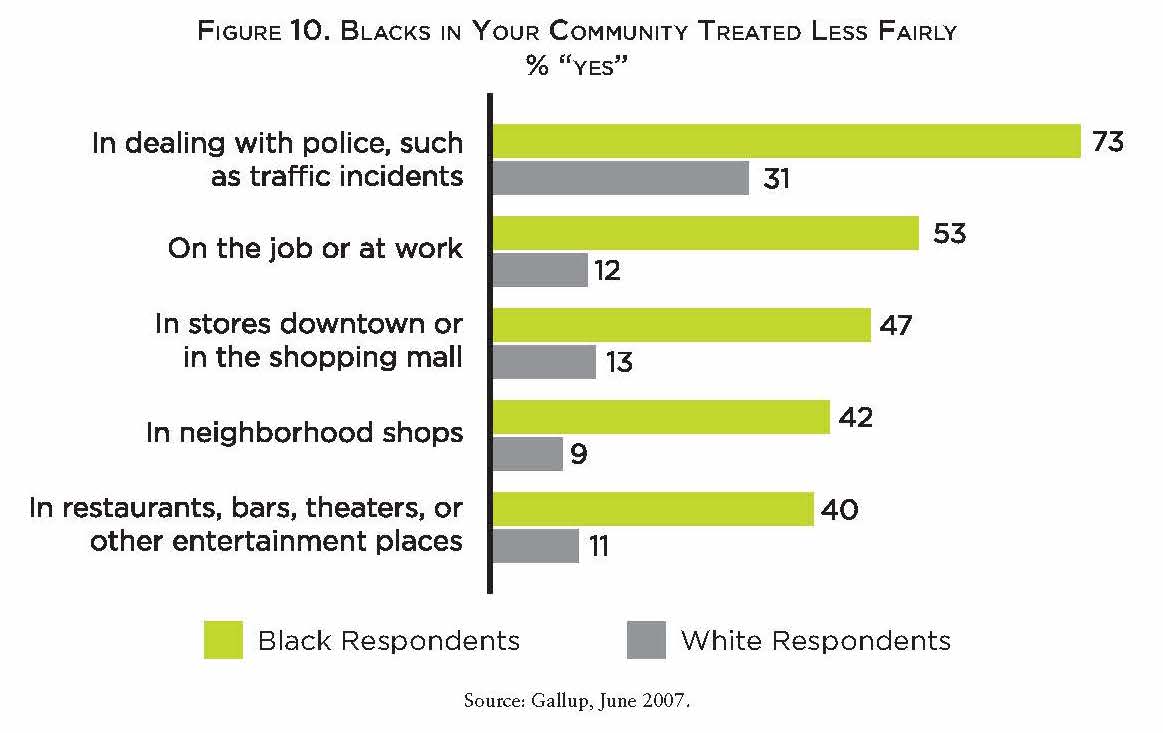
Perceptions of discriminatory treatment vary widely by race. Many black respondents believe that blacks in their community are treated less fairly than whites are, while far fewer white respondents have a similar perception. Note the wide discrepancy in responses between white and black respondents on every measure of discrimination tested. (Gallup, June 2007) Unfair treatment by police is the only category with a considerable percentage of white respondents seeing a problem. Fully 73 percent of black respondents say they see blacks in their community treated less fairly “in dealing with police, such as traffic incidents” while 31 percent of white respondents say blacks in their community are treated less fairly in dealing with police — a 42 percentage point gap. There are similar gaps between the races in their observation of unfair treatment on the job (53 percent and 12 percent, respectively), in downtown stores (47 percent, 13 percent), in neighborhood shops (42 percent, 9 percent) and in places of entertainment (40 percent, 11 percent). (Gallup, 2007) Note: This series of questions straddles both the “interpersonal” and “structural” understandings of the issue of discriminatory treatment, since some examples, such as treatment by police, concern institutions.
The prevalence of the “interpersonal” understanding of this issue embedded throughout public opinion research is troubling for those who care about changing culture and policy. When something as serious as discrimination is commonly trivialized in surveys as being mainly about personal interactions, it obscures the widespread, systemic obstacles and prevents people from seeing the role of collective action and policy change.
Responsibility — structural
Though experts and advocates understand the influence of institutional racism, surveys rarely explore this dynamic. Public understanding of the influence of structures or systems in leading to gaps in achievement is a very limited area of inquiry. Like the questions about relationships and unfair treatment, the few questions that explore some aspect of systemic influences demonstrate opposing views between racial groups.
For example, black Americans see the need for the country to make more changes to achieve equal rights (which implies national policy change), while white Americans disagree. A majority (54 percent) of white respondents believe “our country has made the changes needed to give Blacks equal rights with whites” while just 36 percent believe “our country needs to continue making changes to give Blacks equal rights with whites.” Black respondents feel very differently, with 81 percent believing more changes need to be made. (Pew, 2009) On the economy, most black people said that the economic system is “stacked against Blacks/Black men” while white Americans said that “the system is fair to everyone.”
A split sample experiment demonstrates that some groups may be more willing to see the system as “stacked against Black men” than against black people generally. A majority of black respondents believed America’s economic system is stacked against black men (56 percent of black men and 62 percent of black women agree) while white respondents think the system is fair to everyone (57 percent of white men and 47 percent of white women agree). Responses by black men and white women are consistent across both versions of the question. Black women, however, are more willing to say the system is stacked against black men (62 percent) than it is against blacks as a group (49 percent), and white men become less willing to assert the system is fair to everyone when asked whether the system is stacked specifically against black men rather than blacks as a group (dropping from 69 percent to 57 percent, a 12 percentage point decline). (Washington Post/Kaiser Family Foundation/Harvard University, 2006)
Even though most white respondents believe “the system is fair,” most also recognize that black men face more obstacles advancing in the workplace than white people or black women. While black men are particularly likely to assert this is true (79 percent of black men say they face more obstacles than whites), even white men, the group least likely to acknowledge discrimination, agree black men face more obstacles than whites (59 percent). (Washington Post/Kaiser Family Foundation/Harvard University, 2006)
These limited findings may indicate a foundation on which to build. It may be possible, indeed necessary, to highlight in our conversations the structures that impede black male achievement, so that people more readily recognize the systemic causes of disparities.
Responsibility — personal
With the influence of systems and policies invisible to many, all people, including black men, look to personal responsibility to explain success or failure. In this view, racial disparities exist because individuals of different races are not trying as hard as necessary to achieve. Black respondents have shifted toward a personal responsibility perspective to explain gaps in black achievement since the mid-1990s.
As a general stance, Americans overwhelmingly believe in personal empowerment and self-determination. Given two choices, 82 percent of Americans side with the view that “everyone has it in their own power to succeed” while only 12 percent side with the view “success in life is pretty much determined by forces outside of our control.” Fully 77 percent of blacks believe in self-determination, a far higher percentage than in the mid-1990s when it stood at 66 percent. (Pew, 2009)
Majorities of blacks (61 percent) and whites (58 percent) agree that “Most people who want to get ahead can make it if they’re willing to work hard,” while fewer choose the alternate view, “Hard work and determination are no guarantee of success for most people” (36 percent of black respondents and 41 percent of white respondents). (Washington Post/Kaiser Family Foundation/Harvard University, 2011) Two thirds of all respondents (69 percent) side with the view, “people get ahead by their own hard work,” while the remainder say “lucky breaks or help from other people” are equally important (20 percent) or more important (10 percent). (National Opinion Research Center, 2010)
When race is added to the consideration, most assert that people are responsible for their own fate and place little fault on discrimination.
Given two choices, most Americans side with the view, “Blacks who can’t get ahead in this country are mostly responsible for their own condition” over the alternate view, “Racial discrimination is the main reason why many Black people can’t get ahead these days” (67 percent and 18 percent, respectively). White respondents are particularly likely to side with individual responsibility (70 percent), but even a majority of black respondents agree (52 percent). A majority of white respondents have pointed to individual responsibility since Pew started asking this question in the mid-1990s, and this view has gained traction among black respondents in recent years. (Pew Research Center for the People and the Press and Pew Sociological and Demographic Trends Project, 2009)

A majority (56 percent) of Americans believe the problems facing black men are more a result “of what Black men have failed to do for themselves” than “of what white people have done to Blacks.” White men are most likely to point to individual failure (63 percent), as do 59 percent of black men, 56 percent of black women, and 51 percent of white women. (Washington Post/KFF/Harvard, 2006) Finally, in a series of interviews conducted by Yankelovich/Radio One in 2007, fully 84 percent of black respondents agreed that “Blacks need to be more responsible for themselves as individuals.”
What is unclear, however, is whether “be more responsible for themselves” has the same narrow interpretation across the black community as it would in American culture more broadly. For example, the last statement, “Blacks need to be more responsible for themselves as individuals” might be interpreted as a call for collective action by the black community, for the black community, by at least some people. The same study found 71 percent of blacks saying it is important “to stick together to achieve gains for the community” and that the black “New Middle Class”5 segment was the “most likely to believe that problems in the Black community can best be solved by Blacks and that Blacks need to be more responsible for themselves.” (Yankelovich, 2007) So it may be that in some instances and for some segments of the black community, “personal responsibility” includes collective action.
Generally, the “personal responsibility” approach undermines a role for government in addressing disparities. On a scale of 1-7, where 1 indicates “the government in Washington should make every effort to improve the social and economic position of blacks” and 7 means “the government should not make any special effort to help blacks because they should help themselves” a plurality of black respondents side with the statement that government “should make every effort to improve” their lives (44 percent choose 1-3) over the government making no “special effort … because they should help themselves” (23 percent 5-7). White respondents answer in the reverse (12 percent government help, 54 percent help themselves). (American National Election Studies, 2008)
The rise in the perception that personal responsibility explains success or failure among black Americans has not yet replaced belief that prejudice hinders achievement.
In 2007, 82 percent of black respondents said that it was “important for parents to prepare their children for prejudice.” (Yankelovich) Black men assert that black parents need to both encourage their children that anyone can be successful with hard work, and warn them that they will have to work harder to get credit and that unfairness exists. Few, however, go so far as to say that most white people aren’t trustworthy (see table).

As communicators consider approaches to discrimination, disparities, and stereotypes, these largely invisible tectonics of “who’s responsible?” underlie public understanding and need to be taken into account. If a person believes discrimination is largely a thing of the past, or that discrimination is solely about interpersonal slights and personal racism, or that success is due solely to personal pluck, then a policy conversation seems irrelevant.
The Obama effect
The election of the nation’s first black president had a beneficial effect on people’s assessment of race relations. However, research suggests that Barack Obama’s administration has not ushered in a new era of support for racial policies.
While Americans may have many critiques of Barack Obama, the idea that he is providing preferential treatment to the black community is not typically one of them (though there are some conflicting notions in the research). Only 12 percent overall, and only 13 percent of white respondents, believe that he is “paying too much attention” to blacks. In comparison, more people think he pays too much attention to banks and financial institutions (33 percent), business corporations (25 percent), gays and lesbians (21 percent), and labor unions (17 percent). Black respondents report satisfaction with the level of attention the President is giving to “the concerns of Blacks”: 80 percent say he is giving the right amount of attention, 13 percent say “not enough,” and just 1 percent say “too much.” (Pew, 2009)
In “Change or More of the Same: Evaluating Racial Attitudes in the Obama Era” by Vincent Hutchings (2009), there is little proof that the election of a black president indicates increased support for policies to address racial gaps. Some research suggests that the racial divide on racial policy matters is as wide as ever.
Furthermore, recent research warns that one consequence of Barack Obama’s election may be that people are less likely to believe discrimination is a problem. In pre- and post-election surveys, one researcher noted an 11-percentage point decline in the view that there is “a lot” or “some” discrimination against blacks. More than one in four, or 27 percent, of those surveyed revised their assessment of discrimination downward, and this shift occurred across a range of demographic groups. Declines in ratings of discrimination are associated with an increase in negative views of blacks and increased opposition to affirmative action and immigration. (Valentino, 2011) While it is too soon to know if this portends future obstacles in building public support for policies, advocates should be attentive.
Finally, President Obama’s real influence on the electorate may be more about mood than policy — he lifted black Americans’ assessment of race relations and progress. Americans overall are more likely to believe that Obama’s election made race relations better rather than worse (41 percent better, 22 percent worse), and this view is even more prevalent among black Americans (53 percent better, 20 percent worse). Americans are optimistic that Obama’s presidency will make race relations better (61 percent), a view that is especially held by black Americans (79 percent). (Gallup, October 2009) In fact, just prior to his inauguration, surveys showed a jump in the percentage saying relations between the races are “good.” (Hart/McInturff, 2010)

